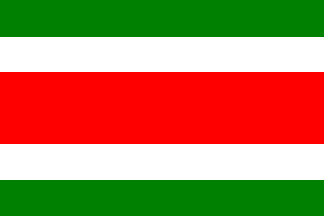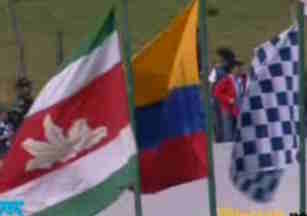 klaus-michael schneider
klaus-michael schneider
Keywords: boyaca | colombia |
Links: FOTW homepage | search | disclaimer and copyright | write us | mirrors

FOTW beschäftigt sich mit der Wissenschaft der Vexillologie (Flaggenkunde).
Alle auf dieser Website dargebotenen Abbildungen dienen ausschließlich der Informationsvermittlung im Sinne der Flaggenkunde.
Wir distanziert uns ausdrücklich von allen hierauf dargestellten Symbolen verfassungsfeindlicher Organisationen.
Last modified: 2021-08-26 by  klaus-michael schneider
klaus-michael schneider
Keywords: boyaca | colombia |
Links: FOTW homepage |
search |
disclaimer and copyright |
write us |
mirrors

image by Blas Delgado Ortiz , 28 May 2000

Oak Leaf Variant
image by Eugene Ipavec, 21 June 2010
See also:
The Boyacá Department (1,400,000 inhabitants; 23,189 sq. km) is located in
the Central West region of Colombia; it is made of 15 provinces and 123
municipalities.
The Boyacá Department was originally settled by the Chibchas and the Muiscas,
two peoples considered as having reached the highest cultural development among
native peoples in northern South America. The Spanish colonists organized the
Tunja Province, one of the biggest and most developed provinces in the New
Kingdom of Grenada, encompassing the today's Boyacá, Santander, and Mérida
Provinces, as well as the southern shore of Lake Maracaibo (Venezuela).
Boyacá is a Chibcha name meaning "the cacique's enclosed place" or ". The Battle
of Boyacá, fought on 7 August 1819, resulted in the end of the Spanish
domination over the New Kingdom of Grenada. The Cúcuta Constitution, which
confirmed in 1821 the independence of Colombia, formed the Boyacá Department, as
a tribute to the famous battle. Articles 8 and 150 of the Law of 8 October 1821
incorporated into the Boyacá Department the Tunja, Socorro, Pamplona, and
Casanare Provinces, as well as the Chiquinquirá and Vélez Districts. On 13 June
1857, the Congress of New Grenada incorporated the Tunja, Tundama and Casanare
Provinces, as well as the Chiquinquirá and Moniquirá Districts into the Boyacá
Sovereign State, divided the same year in the Tunja, Oriente, Tundama and
Casanare Departments. The Political Constitution of Colombia issued in 1886
renamed the Federal States "Departments", one of them being the Boyacá
Department. The today's territory of the Boyacá Department was fixed in 1973,
following the secession of Casanare?
Ivan Sache, 02 June 2012
At <terranew.com/boyaca>
information is given about this flag. I give here the text
available in spanish:
"Aprobación: Ordenanza No. 47 de 1967. Decretos 218 y
495 de 1968, emanadados de la Gobernación de Boyacá.
Diseno y descripción heráldica: Descripción: Doctor Alfonso
Marino Camargo, natural de Duitama.
La Bandera de Boyacá está formada por cinco fajas horizontales:
la primera y la quinta en sinople (verde), que será la sexta
parte del pendón; la segunda y la cuarta en blanco, cada una
será una sexta parte de ésta; la tercera o central en gules
(rojo) ocupando las dos sextas partes.
El Sinople (Color verde) Denota la fe, la sincera amistad, la
devoción de servicio, el respeto y la esperanza en nuevos días,
enmarcando a la vez, la fertilidad de los campos y el verde
esmeralda de su suelo.
El Blanco Significa el apego del boyacense a su terruno y su
dedicación al servicio de la inteligencia y a la decisión
inquebrantable por mantener unidad de su territorio.
El Gules (Color rojo) es el homenaje a quienes rindieron su vida
por la libertad de Colombia y América en los campos de
Boyacá."
Pascal Gross, 22 March 2001
The Spanish text translates as follows:
Approval.
Ordinance No. 47, 1967. Decrees No. 218 and 495, 1968, issued by the Government
of Boyacá.
Design and heraldic description. Dr. Alfonso Mariño Camargo, native from
Duitama.
The flag of Boyacá is made of five horizontal stripes: the first and the fifth
are vert (green), each covering one sixth of the flag's height; the second and
the fourth are white, each covering one sixth of the flag's height; the third,
central is gules (red), covering the two remaining sixths of the flag's height.
Vert (the green color) represents faith, sincere friendship, commitment to
service, respect and aspiration to a new future, showing together the fertility
of the fields and the green emerald of the underground.
White means the attachment of the Boyacá people to their land and their
commitment to the service of intelligence and unwavering decision to maintain
the unity of the territory.
Gules (the red color) is a tribute to those who offered their life for the
freedom of Colombia and America in the fields of Boyacá.
Ivan Sache, 02 June 2012

image located by Esteban Rivera, 7 March 2010
On the
video footage the Boyacá flag seems to have an Oak Leaf in the middle.
Esteban Rivera, 7 March 2010
The flag is actually a variant of the flag of the Departamento de Boyacá.
Esteban Rivera, 21 June 2010
The variant of the departamental flag of Boyaca, in fact is a new flag,
adopted in 2008. Here
is the explanation.
Valentin Poposki, 01 June 2012
The text translates as follows:
Governor José Rozo Millán and the Boyacá Assembly, via Ordinance No. 8 of 5 June
2008, have approved the amendment and symbolics of the flag, with the addition
of a white oak leaf in the middle of the red stripe of the flag. The oak is the
emblematic tree of Boyacá; oak woods stretch over more than 20 municipalities,
forming a stripe from the Guantiva-la Rusia-Iguaque subregion to the northeast
and the municipalities of Soatá and Tipacoque, in the Center and West provinces,
and in the national parks and the Iguaque, Alto Río Fonce and Guanentá
sanctuaries, as well as other nature reserves. The oak woods form the most dense
forest parts of the Boyacá Department. The oak symbolizes the origin, character
and power of the Boyacá people, who are "as strong as an oak".
There is profuse evidence of the use of the flag on the photo galleries of the
official website.
Ivan Sache, 02 June 2012
boy.gif)
image from Boyaca.net
The coat of arms has little, if any, to do with the flag.
I recommend a link to
the official website of the Boyacá Department, where a better image is
presented.
Ivan Sache, 02 June 2012
Hosted by: Fanshop-Online.de und Handy-Shop.de
Tipp: Apple iPhone 12 im Shop